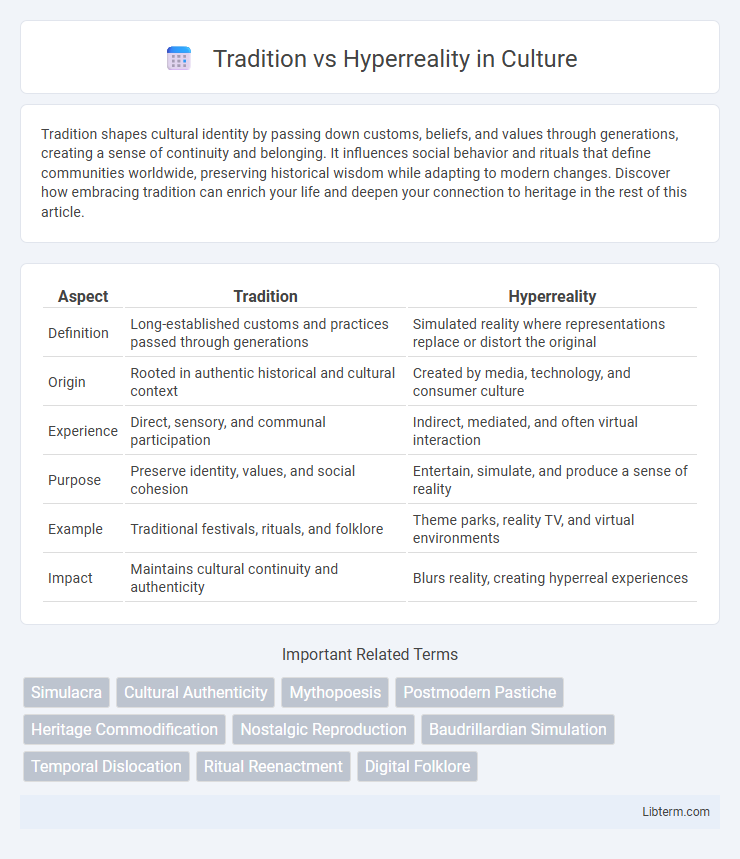Tradition shapes cultural identity by passing down customs, beliefs, and values through generations, creating a sense of continuity and belonging. It influences social behavior and rituals that define communities worldwide, preserving historical wisdom while adapting to modern changes. Discover how embracing tradition can enrich your life and deepen your connection to heritage in the rest of this article.
Table of Comparison
| Aspect | Tradition | Hyperreality |
|---|---|---|
| Definition | Long-established customs and practices passed through generations | Simulated reality where representations replace or distort the original |
| Origin | Rooted in authentic historical and cultural context | Created by media, technology, and consumer culture |
| Experience | Direct, sensory, and communal participation | Indirect, mediated, and often virtual interaction |
| Purpose | Preserve identity, values, and social cohesion | Entertain, simulate, and produce a sense of reality |
| Example | Traditional festivals, rituals, and folklore | Theme parks, reality TV, and virtual environments |
| Impact | Maintains cultural continuity and authenticity | Blurs reality, creating hyperreal experiences |
Understanding Tradition: Roots and Significance
Tradition encompasses inherited customs, beliefs, and practices that provide cultural identity and continuity across generations. Its significance lies in fostering social cohesion and preserving collective memory, shaping values and behaviors within communities. Understanding tradition involves exploring its historical roots and the role it plays in maintaining a sense of belonging amidst changing societal contexts.
Defining Hyperreality: Concepts and Origins
Hyperreality, a concept rooted in postmodern philosophy, describes a condition where the distinction between reality and simulated representations blurs, creating a new, often indistinguishable reality. Originating from Jean Baudrillard's theories, hyperreality challenges traditional perceptions by suggesting that media, technology, and culture produce simulations that replace or surpass the experience of the real. This phenomenon reshapes social and cultural dynamics as individuals increasingly engage with constructed realities rather than authentic, traditional experiences.
Cultural Identity in a Hyperreal World
Cultural identity in a hyperreal world is increasingly shaped by simulated experiences that blur the distinction between authentic traditions and constructed realities. The proliferation of digital media and virtual environments often redefines heritage through hyperreal representations, challenging the preservation of genuine cultural practices. This shift raises critical questions about authenticity, as communities navigate the tension between maintaining traditional identities and adapting to hyperreal influences.
The Transformation of Rituals and Customs
The transformation of rituals and customs in the context of tradition versus hyperreality is evident as authentic cultural practices are increasingly mediated and simulated through digital technologies. Hyperreality blurs the boundaries between genuine traditions and their reproduced versions, resulting in rituals that prioritize spectacle and representation over original meaning. This shift challenges the preservation of cultural heritage by replacing lived experiences with curated, often commercialized, reenactments.
Media Influence: Shaping Perceptions of Reality
Media influence profoundly shapes perceptions of reality by blurring the lines between tradition and hyperreality, where simulated experiences often replace authentic cultural practices. Traditional narratives grounded in historical fact struggle against the pervasive presence of hyperreal media, which constructs idealized or exaggerated versions of reality that audiences accept as truth. This shift impacts societal values and collective memory, altering the way individuals interpret and engage with their cultural heritage.
Authenticity vs Simulation in Modern Life
Tradition anchors identity through authentic practices passed down generations, preserving cultural heritage and genuine experiences. Hyperreality, fueled by digital media and virtual environments, blurs the line between reality and simulation, creating experiences that mimic authenticity but lack original essence. This tension challenges modern life by questioning whether simulated experiences can fulfill the same emotional and cultural significance as traditional authenticity.
The Erosion of Collective Memory
The erosion of collective memory occurs as hyperreality replaces traditional cultural narratives with simulated experiences, diluting authentic historical consciousness. In hyperreality, media and technology create recreated realities that overshadow genuine traditions, leading communities to lose touch with their shared past. This shift undermines the preservation of collective identity by favoring constructed images over lived cultural heritage.
Tradition’s Resilience Amid Digital Disruption
Tradition demonstrates remarkable resilience amid digital disruption by preserving cultural identities through rituals and practices deeply rooted in history. Despite the pervasive influence of hyperreality, traditional customs adapt by integrating digital elements without losing their authentic essence. This dynamic interplay ensures the continuity of heritage in a rapidly evolving technological landscape.
Navigating Values: Preservation or Adaptation?
Navigating values in the context of tradition versus hyperreality involves balancing cultural preservation with adaptive innovation as digital simulations reshape social experiences. Traditional values anchor communities through historical continuity and shared rituals, while hyperreality challenges authenticity by blending reality with mediated representations from platforms like virtual reality and social media. Effective cultural strategies must prioritize both safeguarding heritage and embracing dynamic reinterpretations to maintain relevance in increasingly virtualized environments.
The Future of Tradition in the Age of Hyperreality
The future of tradition in the age of hyperreality involves the transformation of cultural practices into simulated experiences that blend authentic heritage with digital representations. As hyperreality blurs the lines between reality and imitation, traditional rituals and symbols may evolve into interactive, virtual formats that preserve cultural identity while adapting to technological advancements. This fusion challenges conventional notions of authenticity but offers new avenues for cultural continuity and engagement in a digitally saturated world.
Tradition Infographic

 libterm.com
libterm.com